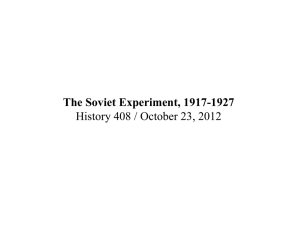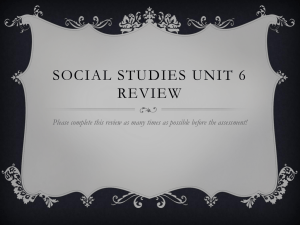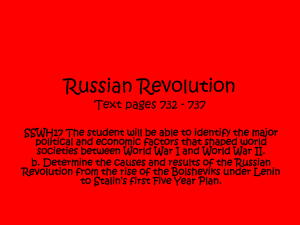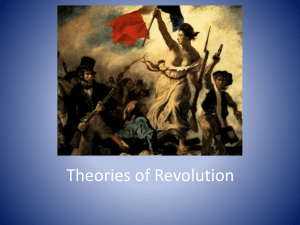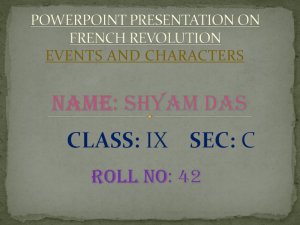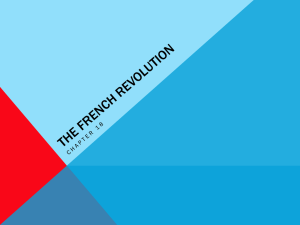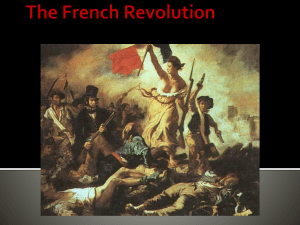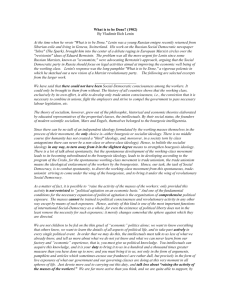PowerPoint
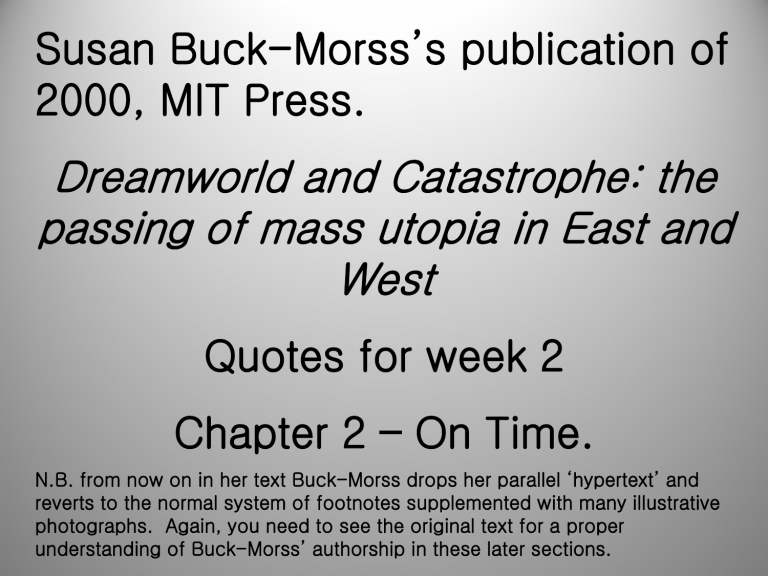
Susan Buck-Morss’s publication of
2000, MIT Press.
Dreamworld and Catastrophe: the passing of mass utopia in East and
West
Quotes for week 2
Chapter 2 – On Time.
N.B. from now on in her text Buck-Morss drops her parallel ‘hypertext’ and reverts to the normal system of footnotes supplemented with many illustrative photographs. Again, you need to see the original text for a proper understanding of Buck-Morss’ authorship in these later sections.
Buck-Morss, 2000, pp. 42-45; sec. 2.1 –
Revolutionary Time.
Buck-Morss starts this section with two quotes which should be noted:-
Friedrich Engles, from his essay ‘On Authority’
A revolution is certainly the most authoritative thing there is; it is the act whereby one part of the population imposes its will upon the other part by means of rifles, bayonets, and cannon – authoritarian means, if such there be at all.
V. I. Lenin, 1921; In some respects, a revolution is a miracle.
Several months after the October Revolution, Anatoli
Lunarcharskii, newly appointed as head of the People’s
Commissariat of Enlightenment (Narkompros), reported to a meeting of artists and sculptors: ‘I have just come from
Vladimir Ilich [Lenin]. Once again he has one of those fortunate and profoundly exciting ideas with which he has so often shocked and delighted us. He intends to decorate Moscow’s squares with statues and monuments to revolutionaries and the great fighters for socialism.’
Lenin had told him that this plan for ‘monumental propaganda’ was for long his cherished idea. It was to be public art that wrote history onto urban space. The masses would
see
history as they moved through the city. The revolution entered the phenomenal world of the everyday
(Buck-Morss’ italics).
Innovative in Lenin’s idea was the adaptation of a nationalist art form for socialist ends. Whereas in the nineteenth century monument-building became an obsession of nation-states as a means of celebrating (and creating) their own particular pasts, Lenin’s monuments evoked an
inter
national heritage. The twenty-one Russians on the list of approved ‘fighters for socialism’ included many assassins or would-be assassins of royalty, not the category normally memorialised by national regimes. There were nineteen Europeans, half of them French, among them a cluster of Revolutionary heroes: Danton, Marat, and
Babeuf; later, Robespierre was added. Cultural figures were among the ‘revolutionaries,’ including Heinrich Heine and Frédéric Chopin. Paul Cezanne’s name was seriously considered (Buck-Morss’ italics).
It is history that legitimates political revolution, at least since Hegel and including Marx. The suturing of history’s narrative discourse transforms the violent rupture of the present into a continuity of meaning. One has to imagine the tenuousness of the situation. With the expected workers’ revolution delayed indefinitely, Lenin counted the days for proof that the Bolshevik victory could outlast the revolutionary Paris Commune of 1871. Why, when even fellow Marxists believed a period of bourgeois democracy in Russia was a historical necessity, should the Bolshevik splinter group gain hegemony, not only of the political discourse but of the cultural discourse as well? Mass support existed for the October events, but it was not of a single mind. Millennialists, avant-gardists, and utopian dreamers of every sort were eager to interpret the revolutionary future as their own.
Bolshevism needed to speak for all of these people, structuring their desires inside a historical continuum that, at the same time, contained their force. In the process of being inserted into the temporal narrative of revolutionary history, the utopian dimension of a wide variety of discourses was constrained and reduced (Buck-Morss: 43; the following image and the next two quotes all feature on page 44).
Ill: Konstantin Iuon, 1921, The New Planet
Maxim Gorky, 1905,
Children of the Sun
:-
We people are the children of the sun, the bright source of life; we are born of the sun and will vanquish the murky fear of death.
Lenin told the British science-fiction writer H. G. Wells, who interviewed him in the Kremlin in 1920, that if life were discovered on other planets, revolutionary violence would no longer be necessary: ‘Human ideas – he told Wells – are based on the scale of the planet we live in. They are based on the assumption that the technical potentialities, as they develop, will never overstep ‘the earthly limit.’ If we succeed in making contact with the other planets, all our philosophical, social, and moral ideas will have to be revised, and in this event these potentialities will become limitless and will put an end to violence as a necessary means of progress.’
Utopian discourses abounded in Russia (and among
Russians in exile) in the decade before the Revolution. It was, then as now, the turn of a century, and the pulse of culture was an alternating current of imagined endings and new beginnings. In a country still inadequately connected by rail, flying machines real and imagined were invested with transformative meaning. The country’s World War 1 bomber was named after Ilia Moromets, the Russian fairytale giant who awoke after forty years in possession of enormous strength. With the sudden popularity of science fiction translated from the West (works by Edward Bellamy,
Jules Verne, H.G. Wells), leading Russian writers began to create their own other-planetary worlds, as the first successes of airborne flight propelled imagination into outer space. Interplanetary travel was a preferred form of social utopian expression.
Aleksandr Bogdonov’s two volume epic,
Red Star
(1908) and
Engineer Menni
(1913) anticipated history by describing a Marxist-communist society existing on Mars.
Maxim Gorky developed a theory of god-building
(
bogostroitel’stvo
) whereby the masses would become
God, creators of miracles and immortal. …
All kinds of social fantasies were sparked by the new industrial technologies. The futurist poetry of Aleksei
Gastev, a metal worker and political agitator before the war, described with passionate enthusiasm the new industrial machines as an animate force with human beings their collective extensions. … Artists of the avant-garde gave expression to the changed anthropology of modern life in forms and rhythms that left the perceptual apparatus of the old world triumphantly behind (ibid., 45).
(Given the significance of Gastev for the first assignment, the following is a later reference to his writings that is not part of the present sequence of Buck-Morss’ text, According to her,
Gastev argued that ‘The power of ‘machinism’ would produce a new human sensorium of electric nerves, brain machines, and cinema eyes; and a global, mass body with collective movements, collective feelings, collective goals’ (ibid., p.
107). She then offers the following quote:-
Creating one world brain in place of millions of brains.
Granted that as yet there is no international language, but there are international gestures, there are international psychological formulae which millions know how to use … In the future this tendency will make individual thought impossible and it will imperceptibly be transformed into the objective psychology of an entire class with its systems of switch-ons, switch-offs, short circuits.)
The Bolshevik Revolution appropriated these utopian impulses by affirming them and channelling their energy into the political project. Liberating visions became legitimating ones, as fantasies of movement through space were translated into temporal movement, re-inscribed onto the historical trajectory of revolutionary time (ibid., 45).
(The following examples are art-works generated shortly after the Revolution, some of which are used by Buck-
Morss in a very useful overview of Soviet art from the
Revolution to the regime’s fall; see her pages 46-69. For more examples, see the accompanying web-page.)
Buck-Morss, 2000, pp. 70-95; sec. 2.2 –
Time Fragments.
This section of Buck-Morss’ chapter is entirely made up of quotes and images – again, you are advised to look at her text for an appreciation of presentational style and to the accompanying web-page for more examples. The image below is one in an extensive series which Buck-Morss provides – all documenting aspects of the embalming and memorialisation of Lenin himself, and later on, other
‘Revolutionary’ leaders. Towards the end of the Soviet era, the techniques that had been developed became a commercial service offered globally.
